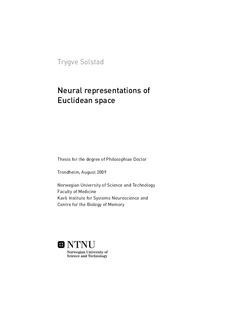| dc.contributor.author | Solstad, Trygve | nb_NO |
| dc.date.accessioned | 2014-12-19T14:21:19Z | |
| dc.date.available | 2014-12-19T14:21:19Z | |
| dc.date.created | 2009-09-25 | nb_NO |
| dc.date.issued | 2009 | nb_NO |
| dc.identifier | 236839 | nb_NO |
| dc.identifier.isbn | 978-82-471-1728-6 (printed ver.) | nb_NO |
| dc.identifier.isbn | 978-82-471-1729-3 (electronic ver.) | nb_NO |
| dc.identifier.uri | http://hdl.handle.net/11250/264026 | |
| dc.description.abstract | Moderne nevrovitenskap bygger på antagelsen om at kognitive fenomener som bevissthet, hukommelse, og stedsans oppstår fra den samlede aktiviteten av individuelle nerveceller. Hjerneområdene hippocampus og entorhinal cortex (EC) er kritiske for hukommelse og stedsans hos både mennesker og dyr. Hos rotter utgjør ’stedceller’ i hippocampus egne kart for hvert miljø rotta utforsker mens ’gitterceller’ i EC utgjør et koordinatsystem som passer til alle miljøer.
Både kart og koordinatsystem finnes i ulike skalaer i den øverste (dorsale) delen av hjerneområdene mens det hittil har vært uklart om dypere (ventrale) deler er involvert i stedsansen. Vi angrep spørsmålet ved å måle aktiviteten i enkeltceller langs hele lengden av begge hjerneområder hos rotter som løp frem og tilbake på en 18m spesialkonstruert løpebane, og fant stedceller og gitterceller langs hele lengden av begge hjerneområdene (Artikkel II og III). Skalaen til både stedcellene og gittercellene økte fra å representere steder på mindre enn 1m i den dorsale enden til opp mot 10 meter i den ventrale enden av hjerneområdene.
Videre utviklet vi en matematisk modell for hvordan minnekart i hippocampus kan være knyttet til stedskoordinater i EC (Artikkel I), og kom fram til et koblingsskjema mellom gitterceller og stedceller som utnytter den systematiske økningen i skala fra dorsal til ventral. Modellen stemmer godt med de anatomiske koblingene mellom EC og hippocampus, og får støtte av nye eksperimentelle data.
Til slutt undersøkte vi hvordan stedskartene i hippocampus er knyttet til miljøets utforming. Tidligere matematiske beregninger har vist at kartenes geometriske forankring kan forklares hvis det finnes en tredje celletype som signaliserer rottas avstand og retning til ulike grenser i miljøet. Vi målte aktivitet i enkeltceller i EC mens rotter utforsket miljøer med ulike geometriske former(Artikkel IV). Blant de andre celletypene fant vi en liten gruppe ”grenseceller” som bare er aktive når rotta løper i nærheten av en vegg eller bordkant.
Avhandlingen fremlegger ny evidens for at beregning av hierarkisk organisert stedsinformasjon er et grunnprinsipp for hvordan hippocampus og EC fungerer (f.eks. ved behandling av minner), påviser en hittil ukjent enhet for representasjon av geometri i EC, og antyder hvordan nevrale enheter kan samhandle for å støtte opp under kognitive funksjoner som stedsans og hukommelse.
| nb_NO |
| dc.description.abstract | As cognitive phenomena are believed to arise from neural activity, uncovering how neurons represent Euclidean one- and two-dimensional space provides a foundation for understanding how the brain organizes and processes information about terrestrial objects and events. Neurons in the hippocampus and medial entorhinal cortex (MEC) of rats exhibit discrete spatial receptive fields at a scale that increases with the neuron’s distance from the dorsal pole of both structures. To find out whether spatial processing is a cardinal function of these structures, we recorded neural activity along the dorsal-most 85% of the CA3 area of the hippocampus (Paper II), and dorsal-most 75% of the MEC (Paper III) while rats explored an 18m linear track. Neurons at all dorsoventral levels of both structures displayed spatial receptive fields, implying functional homogeneity within the hippocampus and MEC. Spatial scale increased from dorsal to ventral in both CA3 and MEC. In hippocampus, field length ranged from less than 1m to more than 10m. In the MEC field length ranged from less than 50cm to approximately 3m, and inter-peak distance ranged from less than 1m to at least 8m. The parallel increase in spatial scale suggests a simple transformation from the repetitive spatial metric of grid cells to the unary place-cell representation of space. Developing a mathematical firing-rate model of place-cell activity to exploit this fact, we showed that place fields can be formed from converging grid-cell inputs that cover a range of spatial scales and orientations but have an overlapping firing peak in the placefield center (Paper I). Inferring metric relationships between entities in hippocampal association maps may therefore rely on interaction with the MEC coordinate system. Because metric information is in turn contingent on the geometric layout of the external environment, we initiated a search for neural representations of geometric features in the parahippocampus. A small proportion (< 10%) of cells that discharged close to environmental borders was found in all cellular layers of MEC as well as in pre- and parasubiculum (Paper IV). ‘Border cells’ typically had a firing field apposing one or more walls of the recording enclosure regardless of enclosure shape, size, or which room the rat was exploring, and responded to any wall, drop, or partition that impeded the rat’s exploration. Taken together, this thesis demonstrates that hierarchically organized spatial processing is an integral property of the hippocampus and MEC, extends the evidence for a modular organization of spatial cognition, and suggests how such modules may interact to support behaviorally relevant functions like spatial memory and navigation. | nb_NO |
| dc.language | eng | nb_NO |
| dc.relation.ispartofseries | Doktoravhandlinger ved NTNU, 1503-8181; 2009:167 | nb_NO |
| dc.relation.ispartofseries | Dissertations at the Faculty of Medicine, 0805-7680; 403 | nb_NO |
| dc.title | Neural representations of Euclidean space | nb_NO |
| dc.type | Doctoral thesis | nb_NO |
| dc.contributor.department | Norges teknisk-naturvitenskapelige universitet, Det medisinske fakultet, Institutt for nevromedisin | nb_NO |
